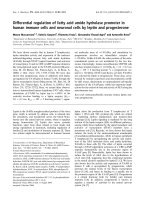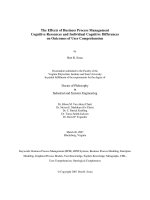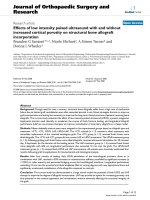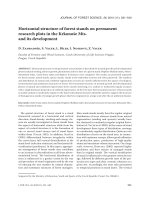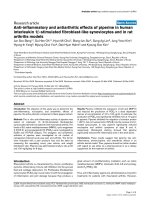Effects of sulfide containing compounds on development of atherosclerosis in human endolthelial cells and hyperlipidemic rabbits
Bạn đang xem bản rút gọn của tài liệu. Xem và tải ngay bản đầy đủ của tài liệu tại đây (7.51 MB, 224 trang )
EFFECTS OF SULFIDE-CONTAINING
COMPOUNDS ON DEVELOPMENT OF
ATHEROSCLEROSIS IN HUMAN
UNDOTHELIAL CELLS AND
HYPERLIPIDEMIC RABBITS
WEN YA-DAN
NATIONAL UNIVERSITY OF SINGAPORE
2013
EFFECTS OF SULFIDE-CONTAINING
COMPOUNDS ON DEVELOPMENT OF
ATHEROSCLEROSIS IN HUMAN
UNDOTHELIAL CELLS AND
HYPERLIPIDEMIC RABBITS
WEN YA-DAN
Master of Medicine, Soochow University
M.B.B.S, Soochow University
A THESIS SUBMITTED FOR THE DEGREE OF
DOCTOR OF PHILISOPHY
DEPARTMENT OF PHARMACOLOGY
NATIONAL UNIVERSITY OF SINGAPORE
2013
Declaration
DECLARATION
I hereby declare that this thesis is my original work and it has been
written by me in its entirety. I have duly acknowledged all the sources of
information which have been used in the thesis.
This thesis has also not been submitted for any degree in any university
previously.
WEN Yadan
25 July 2013
Acknowledgements
Acknowledgements
This work would not have been possible to be achieved without the help of many
people.
In particular, I would like to express my deepest gratitude to my supervisors,
Professor Zhu Yi-Zhun for their excellent and tirelessly guidance for the work
done in this thesis. It has been a great honor and pleasure to work with them
during the past four years. As my Ph.D. supervisor, Prof. Zhu opened the door for
me to the world of an exciting research area – hydrogen sulfide. Prof. Zhu always
gives me confidence in my abilities by showing his own example in his student
life and encourages me promptly once a progress is made in my project. His
dedication and enthusiasm for research impress me very much and set an example
for me during my four-year study.
I would like to express my deep and sincere grateful to my Ph.D. co-supervisor,
Professor Shen Han-Ming for his extensive discussion and laboratory supports,
which have been great value of me.
I would like to thank Professor Tan Kwong Huant, Benny, for his kind help in
animal model establishment and program execution, which are critical to the
completion of this thesis.
I
Acknowledgements
Specifically, I would like to thank Dr. Wang Hong for her kind help on her wide
knowledge and her detailed and constructive comments. Her extremely valuable
experience support and insights have been of great value in my study.
I would like to thank all my colleagues in Pharmacology Research Laboratory for
their assistance with facilitates the completion of this work. I would thank our
collaborators and friends: Ms. Annie Hsu, Ms. Xu Xiao-Guang, Ms. Chan Su
Jing, Dr. Ong Khang Wei, Mr. Woo Chern Chiuh, Mr. Li feng, Mr. Zhao
Heng, Ms. Wu Qi for the discussions and laboratory supports. I also wish to
thank Mr. HARIDASS S/O Suppiah Perumal for his excellent service in lab
apparatus maintenance.
I wish to extend my appreciation to my thesis advisory committee for their
detailed view, constructive criticism and excellent advice during the preparation of
this thesis.
My sincere thanks are due to Animal Holding Unit (AHU), which provides
excellent research facilities for animal study. I am thankful AHU laboratory staff,
Mr. Justin, Mr. Low Wai Mun James, Mr. Loo Eee Yong Jeremy, and the rest of
their assistance and friendship for me.
I would extend my gratitude to Yong Loo Lin School of Medicine, National
University of Singapore for offering the scholarship and providing me with the
opportunity to come to Singapore and pursue my interests.
II
Acknowledgements
Finally, I would like to express my greatest gratitude to my parents, Mr. WEN
Gong-Meng and Mrs. HE Xiu-Zhen for their positive attitude, education and
encouragement in my life. I loved you so much! A special appreciation is given to
my husband Dr. Liang Qian, a Postdoctoral Researcher in SMART, for his
continuous love, encouragement and support in the past four years. I owe my best
bliss and loving thanks to my joyful baby, Liang Xuan-Ming for his cheerful
smiles and love. Without them, I definitely cannot have reached where I am now.
Best love for my parents and my family!
III
Table of Contents
Table of Contents
Acknowledgements ...................................................................................................... I
Table of Contents ...................................................................................................... IV
Summary .................................................................................................................... IX
List of Publication .................................................................................................... XII
List of Table .............................................................................................................XIV
List of Figure ............................................................................................................ XV
List of Abbreviation ................................................................................................XIX
Chapter 1 General Overview ...................................................................................... 1
1.1
Overview ................................................................................................................... 2
1.2
Objectives.................................................................................................................. 5
Chapter 2 Literature review ....................................................................................... 7
2.1
2.2
The Novel Gasotransmitter, Hydrogen Sulfide ......................................................... 8
2.1.1
Introduction ................................................................................................. 8
2.1.2
Physical and biological characteristics ...................................................... 11
2.1.3
Synthesis and catabolism of H2S;.............................................................. 14
2.1.4
Donors and inhibitors of H2S .................................................................... 17
2.1.5
H2S measurements..................................................................................... 26
2.1.6
H2S in inflammation .................................................................................. 31
2.1.7
H2S in redox status .................................................................................... 33
2.1.8
H2S in cardiovascular system .................................................................... 34
Pathophysiology of atherosclerosis ......................................................................... 41
2.2.1
The structure of vessel wall and functions ................................................ 41
2.2.2
Modification of oxidized lipoproteins ....................................................... 42
2.2.3
Monocyte-endothelial adhesion ................................................................ 43
2.2.4
Endothelial dysfunction in atherosclerosis ................................................ 46
IV
Table of Contents
2.2.5
Pathogenesis of atherosclerosis ................................................................. 47
2.2.6
Mitochondria and vascular disease............................................................ 48
Chapter 3 Methods and Materials ............................................................................ 57
3.1
3.2
Drug preparation ..................................................................................................... 58
3.1.1
Materials .................................................................................................... 58
3.2
Synthesis of SPRC .................................................................................... 58
Animals and cells .................................................................................................... 58
3.2.1
Animals ..................................................................................................... 58
3.2.2
Cell culture ................................................................................................ 59
3.3
Hyperlipidemic rabbit model .................................................................................. 59
3.4
Experimental protocols ........................................................................................... 60
3.5
3.4.1
Experimental protocol I ............................................................................. 60
3.4.2
Experimental protocol II ........................................................................... 64
3.4.3
Experimental protocol III .......................................................................... 66
3.4.4
Experimental protocol IV .......................................................................... 69
Experimental techniques ......................................................................................... 71
3.5.1
Cytotoxicity assays .................................................................................... 71
3.5.2
Fluorescent staining of nuclei.................................................................... 72
3.5.3
Cell apoptosis assay .................................................................................. 72
3.5.4
Measurement of H2S concentrations ......................................................... 73
3.5.5
Measurement of CSE activity.................................................................... 73
3.5.6
Preparation of HUVECs Mitochondria ..................................................... 74
3.5.7
Preparation of intact rabbit aorta mitochondria ......................................... 74
3.5.8
ATP Synthesis Recording .......................................................................... 75
3.5.9
Mitochondrial respiration measurement .................................................... 75
3.5.10
Mitochondrial respiratory chain and matrix enzyme activity assays......... 76
3.5.11
Mitochondrial membrane potential - JC-1 staining ................................... 76
3.5.12
ΔΨm measurement ..................................................................................... 77
3.5.13
Measurement of ROS ................................................................................ 77
3.5.14
Lipid peroxidation assays .......................................................................... 78
V
Table of Contents
3.5.15
Cytochrome c Release Assay .................................................................... 78
3.5.16
Transmission Electron Microscopy (TEM) ............................................... 79
3.5.17
Antioxidant enzyme activities assay ......................................................... 79
3.5.18
High resolution ultrasonographic (HRUS) imaging .................................. 80
3.5.19
H&E staining ............................................................................................. 80
3.5.20
Measurement of serum lipid levels ........................................................... 80
3.5.21
Oxidized LDL (ox-LDL) in serum ............................................................ 81
3.5.22
Inflammatory cytokines in serum .............................................................. 81
3.5.23
Immunoblotting ......................................................................................... 81
3.5.24
Real-time Polymerase Chain Reaction (R-T PCR) ................................... 82
3.5.25
Statistical analysis ..................................................................................... 84
Chapter 4 Results ....................................................................................................... 85
4.1
Results of Experiment I: Hydrogen sulfide protects HUVECs against hydrogen
peroxide induced mitochondrial dysfunction and oxidative stress.......................................... 86
4.1.1
NaHS is non-toxic to HUVECs ................................................................. 86
4.1.2
Protective effects of exogenous H2S on H2O2 induced cell death ............. 87
4.1.3
CSE protein and gene expression, CSE activity and H2S concentration
after H2O2-induced injury ............................................................................................... 93
4.1.4
Effects of exogenous H2S on mitochondrial ATP synthesis ...................... 95
4.1.5
Effects of exogenous H2S on mitochondrial membrane permeability ....... 97
4.1.6
Endothelial cell ultrastructure observation .............................................. 100
4.1.7
Effects of exogenous H2S on MDA formation and ROS production ...... 102
4.1.8
Effects of exogenous H2S on antioxidants activities and antioxidants
enzyme protein expressions .......................................................................................... 104
4.1.9
Protective effects of exogenous H2S against H2O2-induced injury though
the inhibition of program cell death pathway and elevation of Akt pathway................ 105
4.2
Results of experiment II: Hydrogen sulfide protects isolated rabbit aorta
mitochondria against hydrogen peroxide .............................................................................. 107
4.2.1
Effects of H2S on mitochondrial ROS production in isolated rabbits aorta
…………………………………………………..………………………107
VI
Table of Contents
4.2.2
Effects of H2S on mitochondrial respiration in isolated rabbits aorta ..... 109
4.2.3
Effects of H2S on mitochondrial ATP synthesis in isolated rabbits aorta 111
4.2.4
Effects of H2S on mitochondrial respiration chain complex and
mitochondrial matrix enzymes in isolated rabbits aorta ................................................ 112
4.3
4.2.5
Effects of H2S on mitochondrial membrane permeability in isolated rabbits
aorta
..…………………………………………………………………………115
Results of experiment III: Protective effects of Hydrogen sulfide on the
development of atherosclerosis in hyperlipidemic rabbits .................................................... 117
4.3.1
Effects of H2S on the CSE/H2S pathway in the hyperlipidemic rabbit ... 117
4.3.2
Effects of H2S on body weight and serum lipids in the New Zealand white
(NZW) rabbits ............................................................................................................... 119
4.3.3
Effects of H2S on atherosclerotic plaques in the thoracic aorta and carotids
of the NZW rabbits........................................................................................................ 122
4.4
4.3.4
Effects of H2S on ultrastructure of thoracic aorta of NZW rabbits ......... 126
4.3.5
Effects of H2S on oxidative modification of LDL in the NZW rabbits ... 128
4.3.6
Effects of H2S on oxidative stress in the NZW rabbits ........................... 130
4.3.7
Effects of H2S on cell adhesion in the NZW rabbits ............................... 134
Results of experiment IV: Protective effects of S-Propargyl-cysteine on the
development of atherosclerosis in hyperlipidemic rabbits .................................................... 137
4.4.1
Effects of SPRC on the CSE/H2S pathway in the hyperlipidemic rabbit 137
4.4.2
Effects of SPRC on body weight and serum lipids in the New Zealand
white (NZW) rabbits ..................................................................................................... 139
4.4.3
Effects of SPRC on atherosclerotic plaques in the thoracic aorta and
carotids of the NZW rabbits .......................................................................................... 141
4.4.4
Effects of SPRC on ultrastructure of thoracic aorta of NZW rabbits ...... 143
4.4.5
Effects of SPRC on oxidative stress in the NZW rabbits ........................ 145
4.4.6
Effects of SPRC on cell adhesion in the NZW rabbits ............................ 148
Chapter 5 Discussion ............................................................................................... 151
5.1
Discussion on experiment I: .................................................................................. 152
5.2
Discussion on experiment II:................................................................................. 159
VII
Table of Contents
5.3
Discussion on experiment III: ............................................................................... 164
5.4
Discussion on experiment IV: ............................................................................... 172
Chapter 6 Conclusion and Future Perspective...................................................... 177
6.1
Conclusion ............................................................................................................ 178
6.2
Limitation of study ................................................................................................ 182
6.3
Future perspective ................................................................................................. 183
Bibliography: ............................................................................................................ 184
VIII
Summary
Summary
As a chronic inflammatory disease of the arterial wall, atherosclerosis is a leading
cause of death and morbidity worldwide. However, current treatments, statins, causing
strong adverse drug reaction lead to unsatisfactory tolerance in patients experiencing
coronary event. Hydrogen sulfide (H2S), as the novel identified gaseous mediator in
mammals, has emerged its protective effect on oxidative stress, inflammation,
cardiovascular disease and neurodegenerative disease. In this study, the therapeutic
potentials of H2S and an analog of sulfide-containing garlic extraction, SPRC on
atherosclerosis in vitro and in vivo were investigated.
In pilot study - experiment I, human umbilical vein endothelial cells (HUVECs), as
the major cells evolved in the initial process of atherosclerosis, were protected by
exogenous H2S (NaHS) against hydrogen peroxide (H2O2) induced oxidative stress
and mitochondrial dysfunction. H2S showed no toxic to HUVECs at μM level. The
results obtained from MTT, LDH releasing and Sulforhodomine B indicated that H2S
increased cell viability damaged by H2O2. For unveiling the mechanisms hidden
behind, the mitochondria, redox status and program cell death were the three targets
focused on. By observed by the staining of Hochest, PI and Annexin V/PI, H2S
reduced apoptotic cells, which may be mediated by increased anti-apoptotic proteins
(Bcl-2 and Bcl-XL) and decreased pro-apoptotic proteins (cleaved caspase-3 and Bax).
Mitochondrial function was reserved by H2S through increasing ATP synthesis. H2S
also maintained the intact mitochondrial membrane by attenuating the dissipation of
mitochondrial electrochemical potential (ΔΨm) and inhibiting cytochrome c releasing.
The production of ROS detected by H2DCFDA and DHE was inhibited by H2S which
elevated GSH, SOD, catalase, GST and GPx. The effects of H2S can be reversed by
inhibitor of CSE, PAG. The antioxidative and mitochondrial protective effects of H2S
may be through CSE/ H2S pathway.
IX
Summary
In experiment II, the mitochondrial protective effect of H2S was further demonstrated
on New Zealand White (NZW) rabbit aortas. After the rabbits aortas were collected,
mitochondria were isolated and accepted the injury from H2O2. H2O2 treatment
resulted in oxidative stress to the aortic mitochondria, which showed a greater extent
of ROS generation by the staining of H2DCFDA and DHE. Under such circumstance,
exogenous H2S (NaHS) not only inhibited ROS generation, but also increased ATP
synthesis. As the main location of producing ROS and ATP, mitochondrial respiration
chain became the investigated target. Oxygen consumption by the respiration chain
was suppressed by H2O2 and rescued by H2S. The activities of mitochondrial
respiration chain complex I, II/III, IV and matrix enzyme α-KGDHC was restored by
H2S. ΔΨm and Δ540 for testing mitochondrial swelling showed H2S prevented the
mitochondria rupture and maintained mitochondrial membrane. PAG showed the
adverse effects of H2S.
In experiment III, H2S showed the inhibition of atherogenesis on NZW rabbit
hyperlipidemic model. The serum were collected to test the cholesterol level, LDL
level and ox-LDL level, which significantly increased by high cholesterol feeding
(HCD). Administration of H2S leaded to a decrease of LDL level and ox-LDL level,
which may be mediated by the activation of HO-1. Aortic lesions detected by H&E
and carotid arterial lesions detected by high resolution ultrasonographic (HRUS)
imaging, showed that the atherosclerotic lesions in arteries were inhibited by H2S
from the decreased intima-media thickness (IMT) and plaques sizes. The diminished
plaques may be due to the suppression of free radicals, activation of antioxidants and
inhibition of cell adhesive and inflammatory molecules. PAG showed the more severe
atherosclerotic lesions. The cardiovascular protection of H2S may be through CSE/
H2S pathway.
In experiment IV, S-Propargyl-cysteine (SPRC), a sulfide-containing molecule and the
structural analog of a garlic extraction - S-allylcysteine (SAC), inhibited early
X
Summary
atherogenesis on NZW rabbit hyperlipidemic model. HCD treatment not only leaded
to significantly increased body weight, serum cholesterol level and LDL level, but
also formed the early atherosclerotic plaques. SPRC decreased LDL level and
inhibited the plaques formation by the observation of aortas by H&E and carotids by
HRUS. The mechanisms of anti-atherogenesis by SPRC may be through the
regulation of redox status and suppression of inflammatory cell adhesion. The
cardiovascular protective effect of SPRC was inhibited by PAG, showing greater
atherosclerotic lesions. This anti-atherogenesis effect of SPRC may be through CSE/
H2S pathway.
In summary, H2S and SPRC carry potential effects on atherosclerotic therapy, through
the endothelial protection, modulation of mitochondrial function, antioxidant effects
and anti-inflammatory cell adhesion.
XI
List of Publication
List of Publication
Journal Papers
1. WEN Ya-Dan, et al. Hydrogen sulfide protects HUVECs against hydrogen
peroxide induced mitochondrial dysfunction and oxidative stress. PLoS ONE
8(2):e53147 (2013).
2. WEN Ya-Dan, et al. Protective effects of Hydrogen sulfide in the development
of atherosclerosis in hyperlipidemic rabbits. Antioxidant & Redox Signaling.
(Submitted).
3. WEN Ya-Dan, et al. H2S - its characterizations, current measurements,
applications and research findings. Trends in Pharmacological Science.
(Submitted).
4. YanFei Zhang, Ya-Dan WEN, et al. SCM-198 attenuates early atherosclerotic
lesions in hypercholesterolemic rabbits via modulation of the inflammatory
and oxidative stress pathways. Atherosclerosis 224(1):43 (2012).
5. Ya-Dan WEN, et al. A case study-drug fever caused by adverse drug reaction.
Journal of Clinical Rational Drug Use. 9, 97-97, 2010.
6. Ya-Dan WEN, et al. Irrational Drug Use Analysis in Pharmacy Intravenous
Admixture Service Center. Longhua Pharmacological Bulletin 54 (2), 2008.
7. Ya-Dan WEN, et al. Drugs Safety in Pregnancy Period. Longhua
Pharmacological Bulletin 53 (1), 2008.
8. Ya-Dan Wen, et al. Neuronal injury in rat model of permanent focal cerebral
ischemia is associated with activation of autophagic and lysosomal pathways.
Autophagy 4:6,1-8;16 August 2008.
9. Ya-Dan WEN, et al. Inflammatory mechanism in ischemic neuronal injury.
Neuroscience Bulletin 22(3), May 2006.
Conference Papers
1.
Ya-Dan WEN, et al. SPRC, a novel water-soluble modulator of endogenous
XII
List of Publication
H2S, attenuates disease progress in autosomal dominant polycystic kidney
disease, Singapore, March 20-21, 2014.
2.
Ya-Dan WEN, et al. Hydrogen sulfide attenuated atherosclerotic lesions in
hyperlipidemic rabbits. Second International Conference on H2S Biology and
Medicine, Atlanta, Sept 20-22, 2012.
3.
Ya-Dan WEN, et al. Autophagic and lysosomal pathways on the rat model of
permanent focal cerebral ischemia. Second International cardiovascular and
neurological disease, Suzhou, China, Jun 10-15, 2006.
XIII
List of Table
List of Table
Table 2- 1 Comparison of nitric oxide, carbon monoxide and hydrogen sulfide.... 9
Table 2- 2 Characteristics of H2S-producing Enzymes ......................................... 15
Table 2- 3 Sources of H2S used in basic scientific researches .............................. 21
Table 3- 1 Grouping for studies of effects of H2S on HUVECs ........................... 62
Table 3- 2 Grouping for studies of effects of H2S on isolated mitochondria ........ 65
Table 3- 3 Grouping for studies of effects of H2S on hyperlipidemic NZW rabbits
....................................................................................................................... 68
Table 3- 4 Grouping for studies of effects of SPRC on hyperlipidemic NZW
rabbits ............................................................................................................ 70
Table 3- 5 The primers used for real-time PCR in experiment I. .......................... 83
Table 3- 6 The primers used for real-time PCR in experiment III and IV. ........... 83
Table 4.1- 1 Antioxidant enzyme activities in each study groups ....................... 104
Table 4.3- 1 The heart function detected by echocardiogram in rabbits of each
group ........................................................................................................... 125
Table 4.4- 1 The heart function detected by echocardiogram in rabbits of each
group ........................................................................................................... 143
XIV
List of Figure
List of Figure
Fig.2- 1Synthesis and catabolism of H2S .............................................................. 13
Fig.2- 2 Structures of H2S releasing molecules .................................................... 20
Fig.2- 3 The chemical structures of SAC, SPC and SPRC ................................... 24
Fig.2- 4 The equation of spectrophotometric method of H2S ............................... 26
Fig.2- 5 The ranges or limits of H2S measurements ............................................. 31
Fig.2- 6 Oxidative phosphorylation, superoxide production and scavenging
pathways in mitochondria. ............................................................................ 49
Fig.2- 7 Role of the mitochondria in apoptosis and necrosis. ............................... 53
Fig.2- 8 Formation, effects and inactivation of ROS in mitochondria ................. 55
Fig.3- 1 A flow chart represents the general outline of the experiment I.............. 63
Fig.3- 2 A flow chart represents the general outline of the experiment II. ........... 65
Fig.3- 3 A flow chart represents the general outline of the experiment III ........... 68
Fig.3- 4 A flow chart represents the general outline of the experiment IV. .......... 70
Fig. 4.1- 1 The cell viability of HUVECs subjected to different concentrations of
NaHS.. ........................................................................................................... 87
Fig. 4.1- 2. The Cell viability of HUVECs subjected to different concentrations of
H2O2.. ............................................................................................................ 88
Fig. 4.1- 3. Cell viability and death assay of HUVECs subjected to different
concentrations of NaHS with or without H2O2. ............................................ 89
Fig. 4.1- 4 The cell viability of HUVECs by Hoechst staining.. .......................... 90
Fig. 4.1- 5 The cell viability of HUVECs by PI staining. ..................................... 91
Fig. 4.1- 6 The percentage of early apoptotic cells stained by Annexin V/PI by
flow cytometry. ............................................................................................. 92
Fig. 4.1- 7 The H2S concentration (μM) in medium for each treatment group..... 93
Fig. 4.1- 8 CSE activities (μmol/h/g) in HUVECs lysate of each group. ............. 94
Fig. 4.1- 9 Effects of NaHS on H2S synthesizing enzyme protein and gene
expressions. ................................................................................................... 95
Fig. 4.1- 10 Effect of NaHS on ATP synthesis. ..................................................... 96
Fig. 4.1- 11 Effects of NaHS on mitochondrial membrane potential (ΔΨm). ....... 98
XV
List of Figure
Fig. 4.1- 12 Effects of NaHS on release of cytochrome c from mitochondria. .... 99
Fig. 4.1- 13 Ultrastructural changes in HUVECs induced by H2O2 using
transmission electron microscopy. .............................................................. 101
Fig. 4.1- 14 Effects of NaHS on lipid peroxidation. ........................................... 102
Fig. 4.1- 15 Effects of NaHS on ROS production. ............................................. 103
Fig. 4.1- 16 Effects of NaHS on protein expressions of antioxidant enzymes. .. 105
Fig. 4.1- 17 Effects of NaHS on protein expressions of proapoptotic and
antiapoptotic proteins.. ................................................................................ 106
Fig.4.2- 1 Effects of H2S on mitochondrial ROS production. ............................ 108
Fig.4.2- 2 Effects of H2S on mitochondrial respiration. ..................................... 110
Fig.4.2- 3 Effects of H2S on ATP synthesis and ATP/O ratio. ............................ 111
Fig.4.2-4 Effects of H2S on activities of mitochondrial respiratory chain
complexes. .................................................................................................. 113
Fig.4.2- 5 Effects of H2S on activities of mitochondrial matrix enzymes. ......... 114
Fig.4.2- 6 Effects of H2S on mitochondrial membrane permeability.................. 116
Fig.4.3- 1 Changes in CSE/H2S pathway in rabbits............................................ 118
Fig.4.3- 2 Changes in body weight, serum lipid in rabbits of each group. ......... 119
Fig.4.3- 3 The cholesterol levels in serum of hyperlipidemic rabbits in each
group.. ......................................................................................................... 120
Fig.4.3- 4 The oxysterols levels in serum of hyperlipidemic rabbits in each group.
..................................................................................................................... 121
Fig.4.3- 5 The levels of blood cells in serum of hyperlipidemic rabbits in each
group.. ......................................................................................................... 122
Fig.4.3- 6 Aortic lesions by H&E staining in hyperlipidemic rabbits in each
group.. ......................................................................................................... 123
Fig.4.3- 7 HRUS images of carotid artery lesions in hyperlipidemic rabbits in
each group.. ................................................................................................. 124
Fig.4.3- 8 Ultrastructures of thoracic aorta of rabbits. ........................................ 127
Fig.4.3- 9 Serum ox-LDL in hyperlipidemic rabbits in each group.................... 128
Fig.4.3- 10 MDA levels in livers of hyperlipidemic rabbits in each group. .... 129
Fig.4.3- 11 HO-1 protein and gene levels in thoracic aortas of hyperlipidemic
rabbits in each group.. ................................................................................. 130
Fig.4.3- 12 Effects of NaHS to the redox state analyzed in livers of
XVI
List of Figure
hyperlipidemic rabbits in each group. ......................................................... 131
Fig.4.3- 13 Proteins expressions of antioxidants in aortas of hyperlipidemic
rabbits in each group. .................................................................................. 132
Fig.4.3- 14 Gene expressions of antioxidants in aortas of hyperlipidemic rabbits
in each group. .............................................................................................. 133
Fig.4.3- 15 Cytokines of cell adhesions in serum of hyperlipidemic rabbits in each
group. .......................................................................................................... 134
Fig.4.3- 16 Aortic proteins expressions of cell adhesion in hyperlipidemic rabbits
of each group............................................................................................... 135
Fig.4.3- 17 Aortic genes expressions of cell adhesions in hyperlipidemic rabbits
of each group............................................................................................... 136
Fig.4.4- 1 Changes in CSE/H2S pathway in rabbits. .......................................... 138
Fig.4.4- 2 Changes in body weight, serum lipid in rabbits of each group.. ........ 140
Fig.4.4- 3 Thoracic aortic lesions by H&E staining in hyperlipidemic rabbits of
each group.. ................................................................................................. 141
Fig.4.4- 4 HRUS images of carotid artery lesions in hyperlipidemic rabbits of
each group.. ................................................................................................. 142
Fig.4.4- 5 Ultrastructures of thoracic aorta of rabbits.. ....................................... 144
Fig.4.4- 6 Effects of SPRC to the redox state analyzed in livers of hyperlipidemic
rabbits of each group.. ................................................................................. 146
Fig.4.4- 7 Proteins expressions of antioxidants in aortas of hyperlipidemic rabbits
of each group............................................................................................... 147
Fig.4.4- 8 Gene expressions of antioxidants in aortas of hyperlipidemic rabbits of
each group. .................................................................................................. 148
Fig.4.4- 9 Cytokines of cell adhesions in serum of hyperlipidemic rabbits of each
group.. ......................................................................................................... 149
Fig.4.4- 10 Aortic genes expressions of cell adhesions in hyperlipidemic rabbits
of each group............................................................................................... 150
Fig. 5-1 Conceptualization of the way in which H2S may influence on
H2O2-induced cell damage by preserving mitochondrial functions and
displaying antioxidative and anti-apoptosis abilities though CSE/H2S
pathway. ...................................................................................................... 158
Fig. 5- 2 Conceptualization of the way in which H2S may influence on
H2O2-induced rabbits aortic mitochondrial damage by preserving
mitochondrial membrane permeability, protecting respiration chain and
matrix enzymes, displaying antioxidation and reserving ATP production
abilities ........................................................................................................ 163
Fig. 5-3. Conceptualization of the way in which H2S may attenuate
atherosclerotic lesions in hyperlipidemic rabbits by inhibiting lipid oxidation,
displaying antioxidative abilities and suppression inflammatory cell
adhesion through the CSE/H2S pathway. .................................................... 170
Fig. 5-4. Conceptualization of the way in which SPRC may attenuate
XVII
List of Figure
atherosclerotic lesions in hyperlipidemic rabbits by inhibiting aortic plaques,
displaying antioxidative abilities and suppression inflammatory cell
adhesion through the CSE/H2S pathway. .................................................... 176
XVIII
List of Abbreviation
List of Abbreviation
ATP= adenosine triphosphate
CAT = catalase
CBS = cystathionine β-synthase
CSE = cystathionine-γ-lyase
ELISA = enzyme-linked immunosorbent assay
GPx = glutathione peroxidase
GSH = glutathione
GST = glutathione S-transferase
H&E = hematoxylin & eosin
H2S = hydrogen sulfide
HCD = high cholesterol diet
H2O2= hydrogen peroxide
HO-1 = heme oxygenase-1
HRUS = high resolution ultrasonography
HUVEC= human umbilical vein endothelial cell
ICAM-1 = intercellular adhesion molecule-1
IMT = itima-media thickness
LDL = low-density lipoprotein
MDA = malonaldehyde
NZW = New Zealand White
XIX
List of Abbreviation
NO = nitric oxide
ox-LDL = oxidized LDL
PAG = propargylglycine
PCR = Polymerase Chain Reaction
ROS = reactive oxygen species
RS = relative-sectional change
SAC= S-allylcysteine
SMCs = smooth muscle cells
SPRC= S-Propargyl-cysteine
SOD = superoxide dismutase
TC = total cholesterol
TEM = transmission electron microscope
Vp = peak flow velocity
XX
Chapter 1
Chapter 1
General Overview
1

